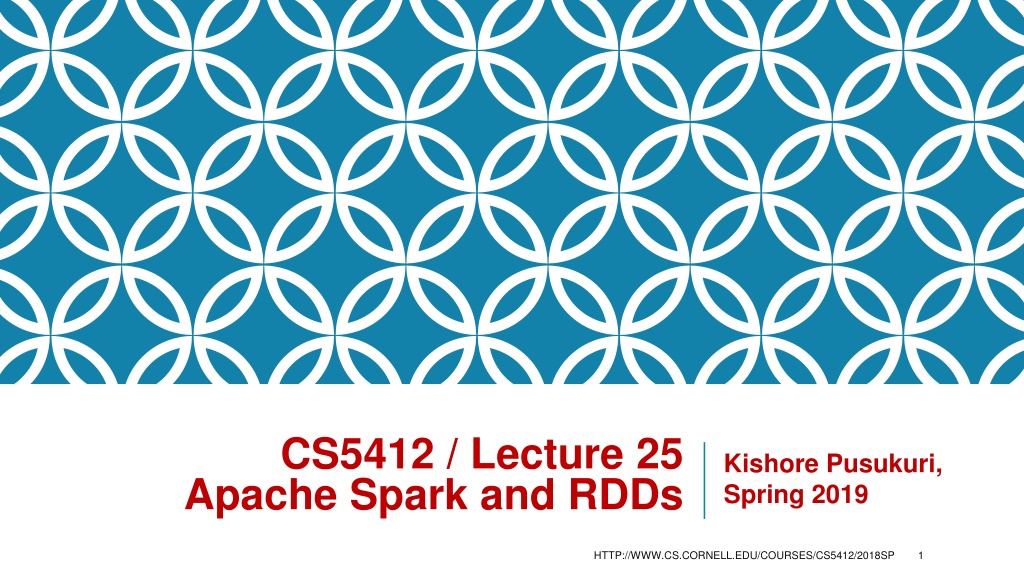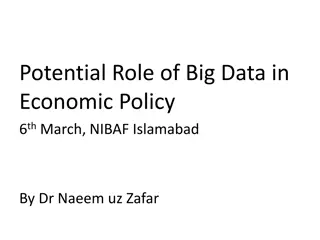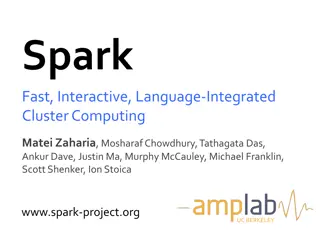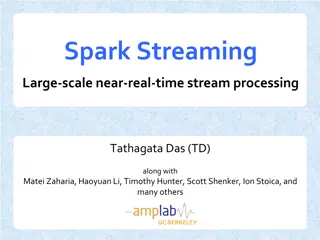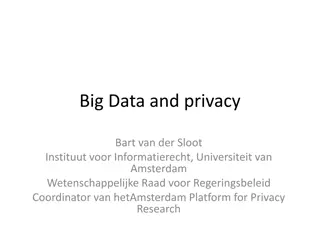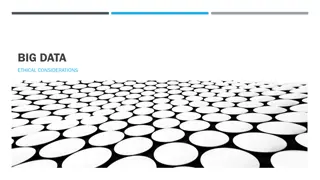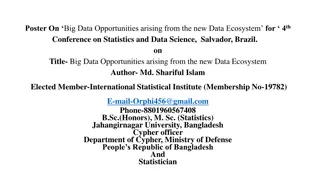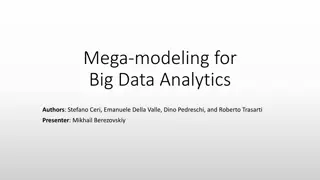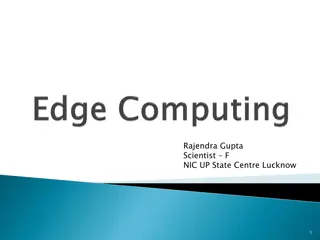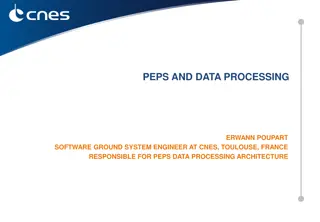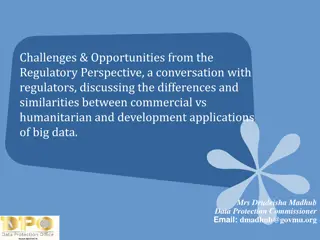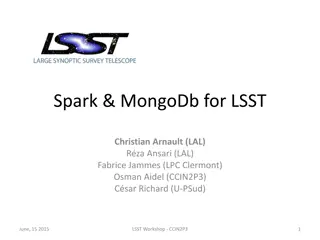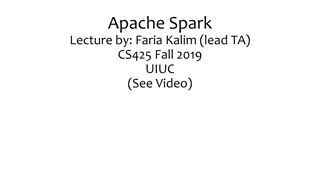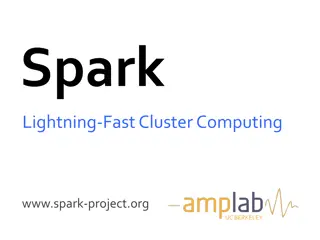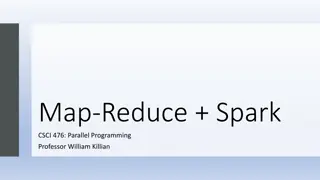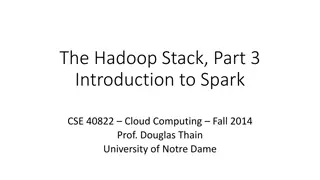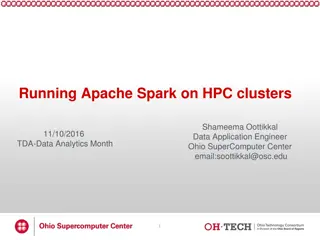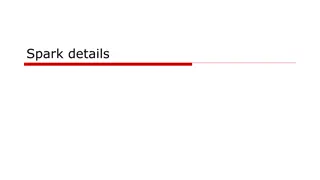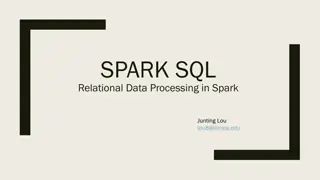Spark: Revolutionizing Big Data Processing
Learn about Apache Spark and RDDs in this lecture by Kishore Pusukuri. Explore the motivation behind Spark, its basics, programming, history of Hadoop and Spark, integration with different cluster managers, and the Spark ecosystem. Discover the key ideas behind Spark's design focused on Resilient Distributed Datasets (RDDs) for efficient parallel processing of big data.
Download Presentation

Please find below an Image/Link to download the presentation.
The content on the website is provided AS IS for your information and personal use only. It may not be sold, licensed, or shared on other websites without obtaining consent from the author.If you encounter any issues during the download, it is possible that the publisher has removed the file from their server.
You are allowed to download the files provided on this website for personal or commercial use, subject to the condition that they are used lawfully. All files are the property of their respective owners.
The content on the website is provided AS IS for your information and personal use only. It may not be sold, licensed, or shared on other websites without obtaining consent from the author.
E N D
Presentation Transcript
CS5412 / Lecture 25 Apache Spark and RDDs Kishore Pusukuri, Spring 2019 HTTP://WWW.CS.CORNELL.EDU/COURSES/CS5412/2018SP 1
Recap MapReduce For easily writing applications to process vast amounts of data in- parallel on large clusters in a reliable, fault-tolerant manner Takes care of scheduling tasks, monitoring them and re-executes the failed tasks HDFS & MapReduce: Running on the same set of nodes compute nodes and storage nodes same (keeping data close to the computation) very high throughput YARN & MapReduce: A single master resource manager, one slave node manager per node, and AppMaster per application 2
Todays Topics Motivation Spark Basics Spark Programming 3
Apache Spark ** Spark can connect to several types of cluster managers (either Spark s own standalone cluster manager, Mesos or YARN) Spark Stream Spark SQL Other Processing Spark ML Applications Data Ingestion Systems e.g., Apache Kafka, Flume, etc Spark Core (Standalone Scheduler) Resource manager Yet Another Resource Negotiator (YARN) Mesos etc. S3, Cassandra etc., other storage systems Hadoop NoSQL Database (HBase) Data Storage Hadoop Distributed File System (HDFS) Hadoop Spark 5
Apache Hadoop Lack a Unified Vision Sparse Modules Diversity of APIs Higher Operational Costs 6
Spark Ecosystem: A Unified Pipeline Note: Spark is not designed for IoT real-time. The streaming layer is used for continuous input streams like financial data from stock markets, where events occur steadily and must be processed as they occur. But there is no sense of direct I/O from sensors/actuators. For IoT use cases, Spark would not be suitable. 7
Key ideas In Hadoop, each developer tends to invent his or her own style of work With Spark, serious effort to standardize around the idea that people are writing parallel code that often runs for many cycles or iterations in which a lot of reuse of information occurs. Spark centers on Resilient Distributed Dataset, RDDs, that capture the information being reused. 8
How this works You express your application as a graph of RDDs. The graph is only evaluated as needed, and they only compute the RDDs actually needed for the output you have requested. Then Spark can be told to cache the reuseable information either in memory, in SSD storage or even on disk, based on when it will be needed again, how big it is, and how costly it would be to recreate. You write the RDD logic and control all of this via hints 9
Motivation (1) MapReduce MapReduce: The original scalable, general, processing engine of the Hadoop ecosystem Disk-based data processing framework (HDFS files) Persists intermediate results to disk Data is reloaded from disk with every query Costly I/O Best for ETL like workloads (batch processing) Costly I/O Not appropriate for iterative or stream processing workloads 10
Motivation (2) Spark Spark: General purpose computational framework that substantially improves performance of MapReduce, but retains the basic model Memory based data processing framework avoids costly I/O by keeping intermediate results in memory Leverages distributed memory Remembers operations applied to dataset Data locality based computation High Performance Best for both iterative (or stream processing) and batch workloads 11
Motivation - Summary Software engineering point of view Hadoop code base is huge Contributions/Extensions to Hadoop are cumbersome Java-only hinders wide adoption, but Java support is fundamental System/Framework point of view Unified pipeline Simplified data flow Faster processing speed Data abstraction point of view New fundamental abstraction RDD Easy to extend with new operators More descriptive computing model 12
Todays Topics Motivation Spark Basics Spark Programming 13
Spark Basics(1) Spark: Flexible, in-memory data processing framework written in Scala Goals: Simplicity (Easier to use): Rich APIs for Scala, Java, and Python Generality: APIs for different types of workloads Batch, Streaming, Machine Learning, Graph Low Latency (Performance) : In-memory processing and caching Fault-tolerance: Faults shouldn t be special case 14
Spark Basics(2) There are two ways to manipulate data in Spark Spark Shell: Interactive for learning or data exploration Python or Scala Spark Applications For large scale data processing Python, Scala, or Java 15
Spark Shell The Spark Shell provides interactive data exploration (REPL) REPL: Repeat/Evaluate/Print Loop 17
Spark Fundamentals Example of an application: Spark Context Resilient Distributed Data Transformations Actions 18
Spark Context (1) Every Spark application requires a spark context: the main entry point to the Spark API Spark Shell provides a preconfigured Spark Context called sc 19
Spark Context (2) Standalone applications Driver code Spark Context Spark Context holds configuration information and represents connection to a Spark cluster Standalone Application (Drives Computation) 20
Spark Context (3) Spark context works as a client and represents connection to a Spark cluster 21
Spark Fundamentals Example of an application: Spark Context Resilient Distributed Data Transformations Actions 22
Resilient Distributed Dataset RDD RDD (Resilient Distributed Dataset) is the fundamental unit of data in Spark: : An Immutable collection of objects (or records, or elements) that can be operated on in parallel (spread across a cluster) Resilient Resilient -- if data in memory is lost, it can be recreated Recover from node failures An RDD keeps its lineage information it can be recreated from parent RDDs Distributed Distributed -- processed across the cluster Each RDD is composed of one or more partitions (more partitions more parallelism) Dataset Dataset -- initial data can come from a file or be created 23
RDDs Key Idea Key Idea: Write applications in terms of transformations on distributed datasets. One RDD per transformation. Organize the RDDs into a DAG showing how data flows. RDD can be saved and reused or recomputed. Spark can save it to disk if the dataset does not fit in memory Built through parallel transformations (map, filter, group-by, join, etc). Automatically rebuilt on failure Controllable persistence (e.g. caching in RAM) 24
RDDs are designed to be immutable Create once, then reuse without changes. Spark knows lineage can be recreated at any time Fault-tolerance Avoids data inconsistency problems (no simultaneous updates) Correctness Easily live in memory as on disk Caching Safe to share across processes/tasks Improves performance Tradeoff: (Fault Fault- -tolerance & Correctness tolerance & Correctness) vs (Disk Memory & CPU Disk Memory & CPU) 25
Creating a RDD Three ways to create a RDD From a file or set of files From data in memory From another RDD 26
Spark Fundamentals Example of an application: Spark Context Resilient Distributed Data Transformations Actions 28
RDD Operations Two types of operations Transformations: Define a new RDD based on current RDD(s) Actions: return values 29
RDD Transformations Set of operations on a RDD that define how they should be transformed As in relational algebra, the application of a transformation to an RDD yields a new RDD (because RDD are immutable) Transformations are lazily evaluated, which allow for optimizations to take place before execution Examples: map(), filter(), groupByKey(), sortByKey(), etc. 30
RDD Actions Apply transformation chains on RDDs, eventually performing some additional operations (e.g., counting) Some actions only store data to an external data source (e.g. HDFS), others fetch data from the RDD (and its transformation chain) upon which the action is applied, and convey it to the driver Some common actions count() return the number of elements take(n) return an array of the first n elements collect() return an array of all elements saveAsTextFile(file) save to text file(s) 32
Lazy Execution of RDDs (1) Data in RDDs is not processed until an action is performed 33
Lazy Execution of RDDs (2) Data in RDDs is not processed until an action is performed 34
Lazy Execution of RDDs (3) Data in RDDs is not processed until an action is performed 35
Lazy Execution of RDDs (4) Data in RDDs is not processed until an action is performed 36
Lazy Execution of RDDs (5) Data in RDDs is not processed until an action is performed Output Action triggers computation, pull model 37
Example: Mine error logs Load error messages from a log into memory, then interactively search for various patterns: lines = spark.textFile( hdfs://... ) HadoopRDD errors = lines.filter(lambda s: s.startswith( ERROR )) FilteredRDD messages = errors.map(lambda s: s.split( \t )[2]) messages.cache() messages.filter(lambda s: foo in s).count() Result: full-text search of Wikipedia in 0.5 sec (vs 20 sec for on-disk data) 38
Key Idea: Elastic parallelism RDDs operations are designed to offer embarrassing parallelism. Spark will spread the task over the nodes where data resides, offers a highly concurrent execution that minimizes delays. Term: partitioned computation . If some component crashes or even is just slow, Spark simply kills that task and launches a substitute. 39
RDD Graph: Data Set vs Partition Views Much like in Hadoop MapReduce, each RDD is associated to (input) partitions 41
RDDs: Data Locality Data Locality Principle Keep high-value RDDs precomputed, in cache or SDD Run tasks that need the specific RDD with those same inputs on the node where the cached copy resides. This can maximize in-memory computational performance. Requires cooperation between your hints to Spark when you build the RDD, Spark runtime and optimization planner, and the underlying YARN resource manager. 42
RDDs -- Summary RDD are partitioned, locality aware, distributed collections RDD are immutable RDD are data structures that: Either point to a direct data source (e.g. HDFS) Apply some transformations to its parent RDD(s) to generate new data elements Computations on RDDs Represented by lazily evaluated lineage DAGs composed by chained RDDs 43
Anatomy of a Spark Application Cluster Manager (YARN/Mesos) 45
Typical RDD pattern of use Instead of doing a lot of work in each RDD, developers split tasks into lots of small RDDs These are then organized into a DAG. Developer anticipates which will be costly to recompute and hints to Spark that it should cache those. 46
Why is this a good strategy? Spark tries to run tasks that will need the same intermediary data on the same nodes. If MapReduce jobs were arbitrary programs, this wouldn t help because reuse would be very rare. But in fact the MapReduce model is very repetitious and iterative, and often applies the same transformations again and again to the same input files. Those particular RDDs become great candidates for caching. MapReduce programmer may not know how many iterations will occur, but Spark itself is smart enough to evict RDDs if they don t actually get reused. 47
Todays Topics Motivation Spark Basics Spark Programming 49
Spark Programming (1) Creating RDDs # Turn a Python collection into an RDD sc.parallelize([1, 2, 3]) # Load text file from local FS, HDFS, or S3 sc.textFile( file.txt ) sc.textFile( directory/*.txt ) sc.textFile( hdfs://namenode:9000/path/file ) # Use existing Hadoop InputFormat (Java/Scala only) sc.hadoopFile(keyClass, valClass, inputFmt, conf) 50
